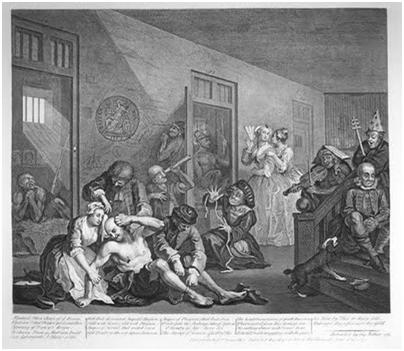In the Victorians were not as successful as the Romans however in combating health despite adopting their practices. They had a theory which involved letting cuts and wounds bleed as they thought it was beneficial. This caused many complications and deaths.
Kings or rules had a special type of gold called a touchpiece, these touchpieces, when touched healed people of illness, and 92,000 people queued, which was alot of people in those times, in the hope of being cured of tuberculosis. One thing they were right about was studying urine, but they didn't have to taste it to gather results. In the Victorian times, people were very superstitious. In the Middle Ages, there was an emphasis on God, religion and prayer. People prayed for their illnesses to be healed.
 ^^ A cartoon depicting a person undergoing painful surgery without anaesthetic is above . It is by William Hogarth, it is called "English Madhouse" and was done in the 18th century. ^^
^^ A cartoon depicting a person undergoing painful surgery without anaesthetic is above . It is by William Hogarth, it is called "English Madhouse" and was done in the 18th century. ^^In those times, people believed that evil smells, air, sex, smoke, scents and excrement caused disease.
They learnt about veins and valves and learnt that blood flows one way and then back again round the body by pressing the wrist hard to obstruct the blood flow and then looking at a vein.
They invented a device to stop bleeding, or blood flow for amputations. They also used leeches to stop blood clots. They also invented the litmus test.
In 1818, they invented blood transfusions, but only in 1901, blood types were discovered which explained the low pass rate of these operations. The AB group was discovered in 1902 to clear confusion.
In 1775, chloroform, a laughing gas, was used as an anaesthetic. In 1846, the first anaesthetic surfaced, which was cocaine derived from coca leaves, which had to be used in small doses. In 1850 they invented the stethoscope for hearing the heartbeat.
In 1853, Queen Victoria used chloroform, an anaesthetic for childbirth giving it the green light to people who were sceptical believing that God only gives as much pain naturally as a person can deal with. Chloroform also has to be used in small doses.
In the 20th century, things started to modernise greatly. Joseph Lister suggested germ theory, that the reason why people get sick for seemingly no reason is that there are germs, too small to see floating around in the air populating around dirty areas being inhaled in by us. This theory was dismissed as nonsense and stupid as there was no proof, and it suggested proof in what can't be seen; as people were more religious in those days, they dismissed claims of weird life existing on this planet.
One thing Joseph Lister made in order to combat this when dealing with wounds, working in hospital was to use carbolic acid. He used this on wounds then covered it in foil, he then used a carbolic spray which stunk and required a gas mask or cloth covering the face, and he also had a cloth covered in carbolic. The carbolic acid was also scrubbed on his hands. However, there was a 9/11 pass rate, a pass rate not heard of in those days.
Carbolic acid kills pathogenic, not human cells making it a bacteride. The
first antiseptic was 'Carbolic acid' (phenol), introduced by Lister in
1867, and two in household use today are 'TCP' (2,4,6-trichlorophenol)
and 'Dettol' (3,5-dimethyl-4-chlorophenol).
 ^^click the image above to zoom
^^click the image above to zoom
Source: British Medical Journal, 1867Later, it was found that boiling, as in sterilisation was the best way to deal with XXX in 1897. This was of great news to the rest of the medics which were not too keen on the carbolic acid..
Only in 1901, blood types were discovered which explained the low pass rate of these operations. The AB group was discovered in 1902 to clear confusion.
In 1920, the x ray was discovered by shooting electrons at a metal, these electrons were absorbed by the metal, and then an x-ray, a form of energy would be converted. As people never knew what there rays were, they were called x-rays. We now know that they are weak gamma rays and are the same rays used by a microphone or to produce an x-ray at the hospital. X-Rays, unlike gamma rays do not produce a health risk of radiation.
Mary Seacole came from another country, and noticed that Britain was going through a crisis with panama cholera so she went to the War Office and taught the country how to deal with it and she got awarded. Basically, all Britain had to do is to ventilate, clear filth, isolate people and help soldiers out.
 History of Medicine
History of Medicine